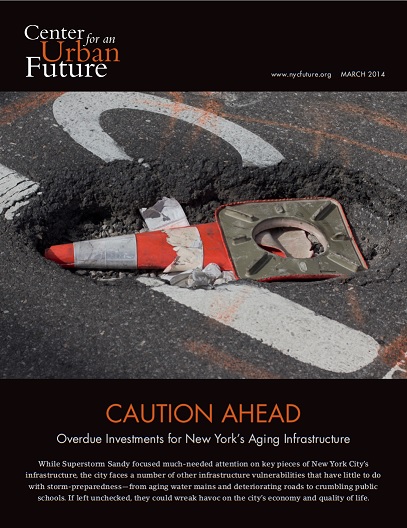 News that the region’s transit ridership is growing coincided with a report this month that offers a sobering reminder of the challenges facing New York City’s critical infrastructure. In its latest report, Caution Ahead, the Center for an Urban Future reminds New York City residents, businesses and elected officials of the ugly truth: that New York City’s transportation infrastructure is old, and it needs help:
News that the region’s transit ridership is growing coincided with a report this month that offers a sobering reminder of the challenges facing New York City’s critical infrastructure. In its latest report, Caution Ahead, the Center for an Urban Future reminds New York City residents, businesses and elected officials of the ugly truth: that New York City’s transportation infrastructure is old, and it needs help:
- 30.4 percent of NYC roads are in “fair” or “poor” condition, up from 15.7 percent in 2000
- 51 percent of highways are rated “fair” or “poor” in 2012 compared to 38 percent in 2008
- 162 of the City’s 1445 bridges – or 11 percent – were structurally deficient
Below ground, the situation is just as dire. New York’s subway is over 100 years old, and the equipment that allows for sequencing of trains isn’t much younger. This system of signals covers 728 miles, 269 of which have exceeded their 50-year useful life. New signals aren’t exactly as sexy an investment as something like new train cars would be, but they are critically important nonetheless. If you’ve ever wondered why some lines don’t have countdown clocks, and why some seem to run on time while others seem to be constantly delayed, these signals are invariably a contributing factor. The subway is so old that even the 13 repair shops built to service these signals and other subway equipment on average were built almost 90 years ago. Continuing to rely on these antiquated facilities simply makes maintaining equipment more costly.
Clearly the City has a lot of needs when it comes to transportation, but with limited funding, prioritization and return on investment are key factors in determining how best to go about upgrading these systems. Investing in the subway is clearly the biggest bang for the buck. Despite a chronic history of underinvestment, the 800-mile system still carries 5.4 million riders per day, for a total annual ridership of 1.7 billion. This keeps millions of cars off the roads, which reduces not only congestion, but also wear and tear. Biking and walking infrastructure can help reduce congestion and wear and tear too, and it’s relatively low cost — not to mention the fact it results in high return on investment in terms of both safety and economic development.
Tri-State has continually highlighted the ongoing need for repairs in calling for transportation departments to adopt fix-it-first policies. But it’s become clear that more revenue is needed if the City is going to make investments in transportation infrastructure beyond simply maintaining a state of good repair. Perhaps the City should consider eliminating parking minimums, creating a residential on-street parking program, and tolling the East River Bridges — all of which could help fund transit improvements. And, if New York State wants to continue to rely on New York City as an economic engine and tax generator, we need to make sure the funds that help prime that economic pump don’t get diverted toward other uses.

[…] As MTR highlighted in an earlier post, federal transportation investments see the greatest economic benefit if they are directed to metropolitan areas. President Obama’s visit presented an opportunity to highlight the infrastructure needs of a region in need of serious transportation upgrades. […]